ARCHIVE · 2019
ANTUN MASLE
Retrospective exhibition to honor the 100th anniversary of birth of Antun Masle
Duration: 14.12.2019. - 1.3.2020.
Curator: Igor Zidić
.jpg)
Antun Masle
Antun Masle is one of the most important painters from Dubrovnik who belongs to so called Dubrovnik coloristic circle, a distinctive variant of "southern expressionism". In his portraits, landscapes and still lifes, Antun Masle uses color similar to Fovist principles, and in his later works approaches the art brute. The author of the exhibition is one of the most famous Croatian historians, theorists and art critics, Igor Zidic.
.jpg)
Autoportret s pticom, 1968., ulje/papir, 29 x 23 cm, slikarovi nasljednici, Dubrovnik
The exhibited art is owned by national museums and galleries, such as the Museum of Modern Art Dubrovnik, the Split Art Gallery, the Zagreb Modern Gallery, the Museum of Contemporary Art in Zagreb, the Museum of Modern and Contemporary Art in Rijeka, the National Museum in Zadar, the City Museum in Rovinj, and artworks from various private collections will be on loan, of which the collection of the heirs of Antun Masle is of particular importance. Antun Masle had his last retrospective exhibition at the Museum of Modern Art Dubrovnik in 1984, so it will be valuable for introducing the younger generation to his work.
.jpg)
Aktovi pod maslinama, oko 1941., tempera / papir, 36 x 51 cm, slikarovi nasljednici, Dubrovnik
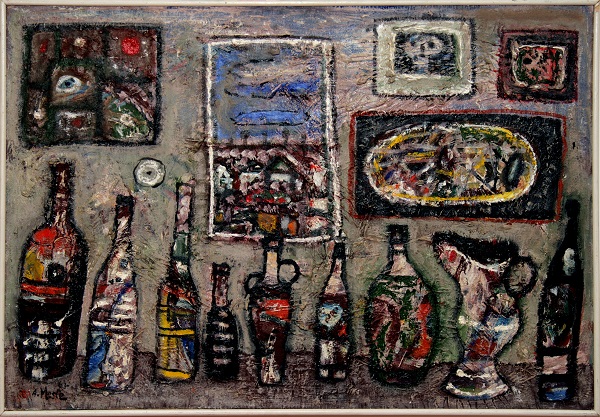
Boce i slike, 1963., ulje / platno
JOSIP MIJIĆ
LIFE IN A BOX
Location: Gallery Dulcic Masle Pulitika
Duration: November 21, 2019 – January 19, 2020
Curator: Nataša Lah
.jpg)
K 3226, 2016., kombinirana tehnika | mixed media, 32 x 26 cm
“Because a palimpsest is a text written on a piece of parchment from which a previous text has been scraped off... because a palimpsest is two in one, a constant deletion of the written and an incessant writing on the e-rased. And because appropriation is annexation and arrogation, symbolically emphasised in the theological appropriation of the three in one, in the only figure that has adopted the form of oneness through the trinity of the most diverse forms of experience and existence in this world.”
Nataša Lah
.jpg)
K 48562, 2016., kombinirana tehnika | mixed media, 48,5 x 62 cm
Biography:
Josip Mijić was born on April 11, 1975, in Travnik. In 2002, he took his BFA at the Academy of Fine Arts of Mostar University, Široki Brijeg campus, in the class of Anto Kajinić. In 2005 he completed the Ars Sacra graduate course, supervised by the same teacher and acquired the degree of Master of Ars Sacra. At the Academy of Fine Arts of Mostar University in 2010/2011 he started working on his doctoral dissertation in the area of art, field of visual arts, painting, his topic being entitled “The Dark and the Material in the Visualisation of the Transcendental in Sacred Painting”, supervised by Professor Kajinić. He received his doctorate in 2017 at the Široki Brijeg Academy of Fine Arts.
From 2003 to 2012 he was an instructor and senior instructor in the theory of space course; from 2003 to 2018 instructor and senior instructor in the computer graphics course. Since 2018 he has been assistant professor, and from 2013 to 2018 was senior instructor in the small nude course in the fourth year, from 2018 assistant professor and from 2014 to 2018 senior instructor in the small nude course of the third year, and since 2018 he has been an assistant professor at the Academy of Fine Arts in Široki Brijeg. He was webmaster of the internet site of the Academy of Fine Arts in Široki Brijeg, from 2006 to 2015.
From 2006 to 2012 he was executive editor and member of the editorial board of Akademija, published by the Academy of Fine Arts of Široki Brijeg and the Franciscan Gallery. In 2007 he was member of the jury at the 28th international competition in the mini-print in Cadasque (Spain). He took part in the workshop Preventive Protection in Museums – Care and Protection of Collections, held in the National Museum of Bosnia and Herzegovina and in the Fine Art Gallery of Bosnia and Herzegovina in Sarajevo in 2008. He accepted an invitation to take part in the international art project The Same Wind The Same Rain held in Chiang Mai in Thailand in 2012. He had a residence in the Cité internationale des arts in Paris in the name of ULUBIH in 2013. He was a member of the organising team of the international Bomb Gallery project held in Mostar in 2014. In 2018 he had a Kamov residency in Rijeka.
He is the author of two stained glass pieces in the Church of the Assumption in Trebižat near Čapljina, six pieces of stained glass in the Church of St Elijah in Masna Luka at Blidinje, five pieces of stained glass in the Church of St Francis of Assisi in Čaplina, a stained glass piece in the Chapel of St Francis in Gornji Vukšić and did three of the stations of the Way of the Cross in the Church of the Annunciation in Široki Brijeg. His undergraduate dissertation Art Informel in Croatian Painting was published in the first issue of the journal for art, culture and science Akademija of the Academy of Fine Arts of Široki Brijeg and the Franciscan Gallery. He is a member of the Croatian Artists’ Association of Split, the Croatian Artists’ Association of Zagreb and the Alumni of the Academy of Fine Arts at Široki Brijeg.
His works are in numerous artistic collections: the Franciscan Museum and Geallery of Široki Brijeg (Široki Brijeg, Bosnia and Herzegovina, the Fontics Gallery in Grožnjan and elsewhere. He has received numerous prizes and commendations, as follows. Second Prize at the competition exhibition Motifs of the Passion, Mimara Museum, Zagreb, 2005; First Prize at the 27th international competition in the miniprint in Cadesques (Spain), 2007; Painting Prize at the 6th International Miniatures Exhibition of Bosnia and Herzegovina in Tuzla, 2011; Second Prize at the international exhibition of miniatures called Minimum Maximum 4 in Banja Luka, 2013; Third Prize at the competition exhibition Change of the Association of Croatian Artists of the Federation of Bosnia and Herzegovina in Mostar, 2016; Prize at the Autumn Art Salon, 2016, of the Association of Croatian Artists of the Federation of Bosnia and Herzegovina in Mostar in 2016; First Prize in the sculpting category and Grand Prix in the first salon of the art of the miniature in Rijeka – Rijeka Mini Art, 2017; Special Prize at the second salon of the art of the miniature in Rijeka – Rijeka Mini Art 2017. To date he has had 29 solo shows and taken part in more than 190 collective exhibitions at home and abroad.
.jpg)
K 507885, 2016., kombinirana tehnika | mixed media, 50,7 x 88,5 cm
MILAN KONJOVIĆ
EMOTIONAL REGIONS OF THE SPIRIT
Duration: 31.10. - 8.12.2019.
Curator: Vesna Delić Gozze
.jpg)
PIROŠKA PRÄGER-RADAUŠ, A FEMALE PORTRAIT, 1936., oil on canvas, 64 x 53 cm
If artistic expression is the result of the creation of the new and constitutes a space of personal freedom, the painting oeuvre of Milan Konjović expresses all the power of a particular and individual vision. Konjović’s dream work is always brought into play and remains along with the visible reality of the material world, and yet also comes into being as a personal, immediate commentary, in which sensory perception is transformed into the prevailing impression of personal reaction to external stimuli. He underwent a stylistic change from the preponderant formation of volume and a restricted range of colours to a new and dominating intensity in the handling of colouring. This is a creative trajectory that occurred in a similar way in the context of the visual art of the wider area of south-east regions. Miodrag Protić recognised two historical epochs in artistic creation, with a watershed round about 1950, in which the previous version of Expressionism was expressed above all by the painterly shaping of volume.
.jpg)
BUNIĆEVA POLJANA IN DUBROVNIK,THE PERIPHERY, 1947., oil on canvas, 87,5 x 114,5 cm, Muzej likovnih umjetnosti, Osijek, MLU-S-1036
.jpg)
GRAIN, 1953., oil on hardboard, 47 x 81 cm, Muzej moderne i suvremene umjetnosti, Rijeka, MMSU-404
Milan Konjović belongs, according to Protić’s structural diagram, to the expressionism of the newer type, and to the pre-war generation of painters that includes Lubarda, Milunović, Postružnik, Pregelj, Mihalič, Omers, Stupica and Hegedušić. While a parallel phenomenon is that of the expressionist and poetic realism of Milosavljević and Kos, in most of the painters, it is the expression of construction and shaping that prevails, which would refer to Konjović, Bijelić, Dobrović, Job, Šumanović, Babić, Herman, Tartaglia, Gecan, Uzelac, Šulentić and Zora Petrović, as seen in the 1920s, as the plane of contact of the influence of Cézanne, Cubism and the renovated tradition, which, in the case of Konjović, developed in time into the febrile dynamism of Expressionist visions. At the very end of his life and career, with his brush reducing his creative oeuvre of animated geography of motifs, Konjović drew a circle with a dot in the middle: a visual explanation of his mission as painter with a destined calling.
.jpg)
COASTAL LANDSCAPE, 1938., ulje na platnu / oil on canvas, Umjetnička galerija, Sarajevo, inv. br. 1151
.jpg)
STILL LIFE, 1932., oil on canvas, 81 x 64,5 cm, Moderna galerija, Zagreb, inv. br. MG-1201
THE SPACE OF EXHIBITION
Nina Kurtela, Maja Marković, Natalija Škalić
Duration: 26.9. - 27.10.2019.
Curator: Rozana Vojvoda
Nina Kurtela, Maja Marković and Natalija Škalić are three contemporary Croatian artists who are linked not only by their generation and their having been trained at the Academy of Fine Arts in Zagreb but also by their propensity to experiment in media and by their highly developed sensitivity for the gallery or museum space that is very often an integral part of their artistic practices. In consequence, the idea for a joint exhibition by these artists draws on those works of theirs that have powerfully expressed references to the space of exhibition. In the case of Natalija Škalić, a sculptor by training, we are dealing with models / metaphors of space that start a dialogue with the exhibition venue in which they are housed. In Maja Marković, a trained painter, we have drawings and geometrical constructions that emphasise fragility and impermanence, undermining the categories of space as stable and unambiguous. In Nina Kurtela, also a painter by training, we are looking at photographs of galleries in Berlin, which in a post-conceptual manner, with minimalist aesthetics, the artist has reduced to fragments of gallery walls that raise the issue of the actual gallery system, the status and context of works of art.
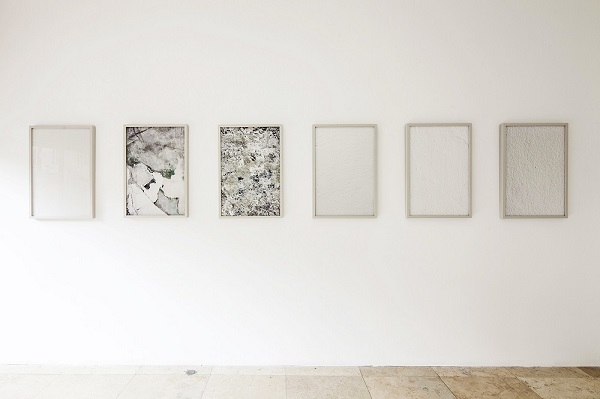
Nina Kurtela, The Wall in Art, 2015-2017
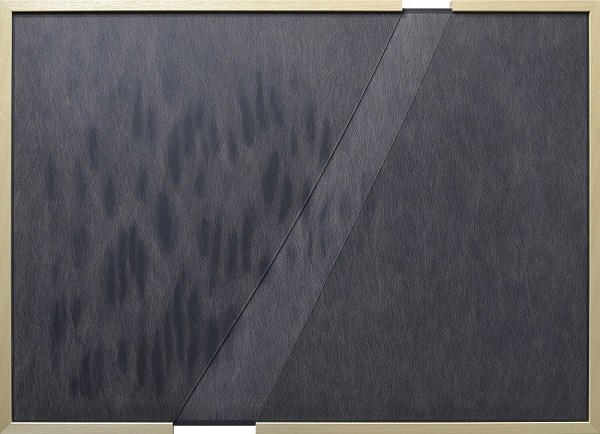
Maja Marković, All Structures are Unstable, 2019
Natalija Škalić, from the cycle Perpendicularly on Horizontal Surfaces, 2016
Biographies:
Nina Kurtela is a visual artist born in Zagreb in 1981. She took a degree in painting in the education section of the Academy of Fine Arts in Zagreb, class of Ante Rašić. She subsequently took a second degree at UdK Berlin – contemporary dance, choreography and context department. She has spent time at a number of residential programmes, exhibited and presented her works around the world, in museums and galleries, at theatre and dance festivals, and in public spaces in Paris, Maastricht, London, New York, Helsinki, Pančevo, Tokyo, Taipei, Dubrovnik, Berlin, Vienna, Zagreb, Sarajevo, Portland and Warsaw. She was on the short list for the Berlin Art Prize in 2018 and has won a number of prestigious prizes such as Japanese Media Arts New Face Award, Tokyo, 2017; X-border Art Biennial Award, Sweden, 2013; Henkel Art Award CEE, Vienna 2011; Essl Art Award CEE, Vienna 2007. She founded the art organisation called Jagoda which is concerned with research into and opening up new fields of communication and exchange through innovative artistic practices. She lives and works in Zagreb and Berlin.
Maja Marković is a visual artist born in 1979 in Zagreb. She took a degree in painting in the education section of the Academy ofFine Arts in Zagreb, class of Ante Rašić. She has exhibited at numerous collective exhibitions and has won numbers of plaudits for her work, attending several residential programmes and artistic research projects. She has exhibited solo in 2018 in the Vjenceslav Richter Collection, the MCA in Zagreb, the Flora Gallery in Dubrovnik; in 2016 in the French Pavilion in Zagreb (with E. Engelbert); in 2015 at Academy Schloss Solitude in Stuttgart; in 2014 in the Događanja Gallery in Zagreb; in 2012 at the Otok Gallery, LAW, Dubrovnik, and at many other exhibitions. She lives and works in Zagreb.
Natalija Škalić is a visual artist born in 1980 in Zagreb. She took a degree in sculpting at the Academy of Fine Arts in Zagreb, class of Peruško Bogdanić. She has taken part in numerous collective shows, multimedia projects and workshops. She has exhibited solo in 2018, Salon Galić in Split; in 2016 in the VN Gallery in Zagreb; in 2014 at the Flora Gallery Dubrovnik and the Bukovac House in Cavtat; in 2012 in the Greta Gallery in Zagreb, and at many other exhibitions. She authored a sculpture in public space called Diver in Vrsar, Istria. She has taken part in the set designs for the short films Easter Egg and Child. She lives and works in Zagreb.
ENTHUSIASM FOR INK WASH PAINTING — CNAP Ink Wash Painting Art Exhibition
August 23 - September 22, 2019, Museum of Modern Art Dubrovnik
Exhibition coordinators: China National Academy of Painting: Nan Zhang, Museum of Modern Art Dubrovnik: Jelena Tamindžija, Ministry of Culture of the Republic of Croatia: Iva Hraste Sočo, Iva Mostarčić, Romana Brajša

LIU Jian, Florence, 2018
Inside the exhibition Enthusiasm for Ink Wash Painting, contemporary ink wash paintings explore the culture obligations and emotional commitments required for creating the value system of Chinese ink wash painting. The works balance both a solid traditional, cultural basis with distinctive contemporary characteristics. Coming into form under the influence of a strict Chinese ink wash value system and the backdrop of globalization, this exhibition aims to display the intricacies of ink wash painting as unique to the medium. Ink wash painting is capable of portraying the reality of daily life while understanding the spiritual endurance of contemporary people, continually acknowledging the role of art in building human civilizations.
Embodying Chinese history and culture while reflecting the painter’s personal experience, the freehand brushwork central to ink wash painting allows great attention towards an individual’s own spiritual feelings. During the century-long development of the form, the characteristic of focusing on the aesthetic standards of traditional scholars was developed alongside the independent language system that integrated poetry, calligraphy, painting and seals art. 100 years ago marked the New Culture Movement beginning the modernization of Chinese culture, with ink wash painting witnessing significant transformation in concept, form, and language. Now, following the 40-year reform and opening up, present Chinese ink wash painting displays diverse values and artistic forms.

ZHANG Jiangzhou, Faded Flower, 2012
Exhibited here are the latest ink wash paintings created by artists from the CNAP. Closely related to traditional Chinese ink wash painting, these pieces are characterized by their diverse aesthetic standards and language forms, displaying the artistic freedom and energetic personalities of contemporary artists. Nature works showing mountains, waters, flowers, and birds express concerns for humanity, while figure paintings portraying the living environment examine the spiritual condition of the modern civilization. The paintings seek to convey the independent value system of contemporary artists, and their unique ideas regarding political and cultural issues. The globalization and localization, spiritual and linguistic issues, are all held under the present cultural backdrop.

YAO Dawu, Fairyland III, 2019
In this smaller collection of paintings, the diversity of art forms allows the condition of contemporary Chinese ink wash painting to be displayed comprehensively. From these paintings, it is evident that the traditional ink wash painting has been revitalized by contemporary artists. The form has become an essential carrier of people’s concern for humanity, showing the characteristics and spiritual connotations of Chinese culture through its own unique value system.
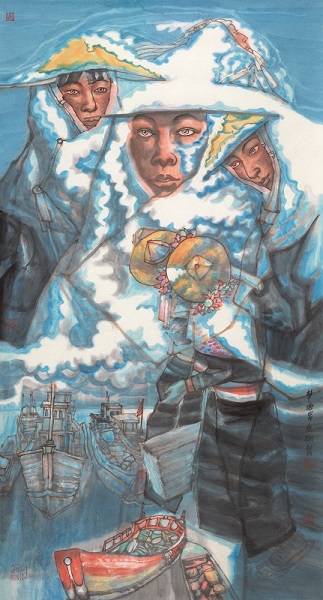
JI Lianbin, Sea Dream III, 2015
Far from China - the cradle of ink wash painting - we hold the exhibition in Europe with the aim of helping European people to develop their understanding of Chinese ink wash painting. They can feel the charm of Chinese art, and acknowledge the thought-provoking wisdom that the works embody hoping that this exhibition will both promote cultural exchanges, and become a bridge for mutual cultural learning and interconnectivity between our people.
KRISTINA RESTOVIĆ
TOURISTS
Location: Gallery Dulcic Masle Pulitika
Duration: 16.5. - 30.6.2019.
Curator: Rozana Vojvoda
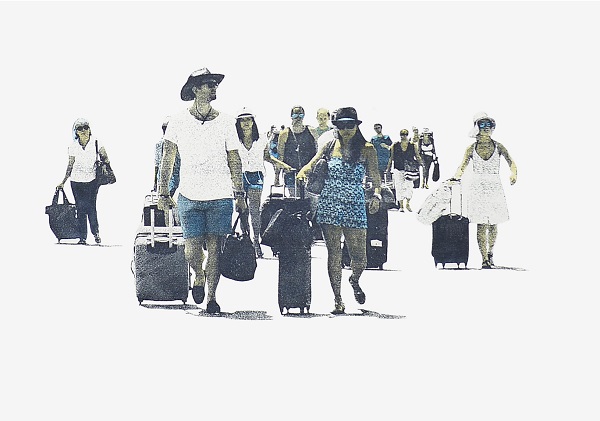 They are coming, 2017,, digital print on zinc plate, etching,, watercolour, paper, 35 x 50 cm
They are coming, 2017,, digital print on zinc plate, etching,, watercolour, paper, 35 x 50 cm
The exhibition Tourists by the brilliant graphic artist Kristina Restović is a story about the touristy Split that the generation of the author, born in the 1970s, has come to know only recently. In the Dubrovnik Dulčić Masle Pulitika Gallery located within the city walls, it symbolically heralds the beginning of the season and scenes similar to those in the prints on show. In her interpretation of the phenomenon of tourism in her native Split and in the neighbouring islands (Hvar), the artist gives a diagnosis of all the cities of the scorching Mediterranean and the hectic atmosphere that the excessive influx of visitors brings. The prints in the show are actually the final product of what is in essence a performative act by the artist – research into the phenomenon of the flows of tourists, their trajectories and their presence within the same routes she moves along herself. All the prints have been produced from her own computer-processed and visually modified photographs, which she then prints in reverse on zinc plate and subjects to her primary graphic medium, the classic techniques of etching and drypoint. This hybrid of digital photography and printmaking techniques gives rise to uncommon visual effects in which the somewhat grainy effect of the digital photograph printout is combined with the
precision of the printmaker’s performance.
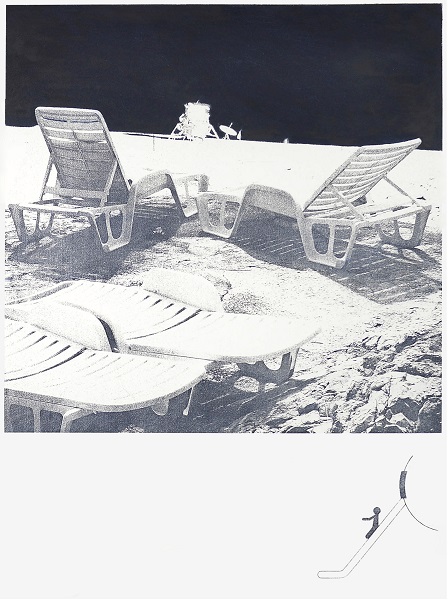
Dreams 1, 2017, digital print on zinc plate, etching and drypoint, paper, 70 x 50 cm
BIOGRAPHY:
Kristina Restović was born in Split in 1973. She took a first degree at the Academy of Fine Art in Florence in 1997, and a master’s at the Academy of Fine Art and Design in Ljubljana in 2007. From 1999 she worked part time for the Art Academy of Split University, since 2014 as associate professor in the contemporary graphic art chair in the painting department. She has exhibited at some thirty solo shows and more than seventy group exhibitions in Croatia and elsewhere. Her work in art has won her a number of prizes: Museum of Contemporary Art Prize, 7th Triennial of Croatian Graphic art: Current poetics of Croatian graphic artists (2016); one of three equal firsts at the 38th Split Salon: Fancying – Relocating (2013); Graphic Art Collection of the National and University Library Prize, 5th Triennial of Croatian Graphic Art: Subversion of the Collective (un)Conscious (2009); Dialogue Prize 2nd International Graphic Art Biennial, Splitgraphic: Dialogue (2005); special mention of the jury, 1st Salon of Graphic Art (2001). In 1996 she won a one-year grant of the Il Bisonte School for specialisation in art graphics, Florence. Her works are kept in the holdings of the Museum of Fine Art in Split; the Department of Prints and Drawings of the Croatian Academy of Sciences and Arts; the Graphic Art Collection of the National and University Library; the Museum of Contemporary Art in Zagreb; the Museum of Modern and Contemporary Art in Rijeka. In 2017 her print portfolio Tourists was published in the Argola imprint of the Department of Prints and Drawings of the Croatian Academy of Sciences and Arts. She is a member of the Split branch of the Croatian Artists Association and of the Croatian Association of Independent Artists. She lives and works in Split.
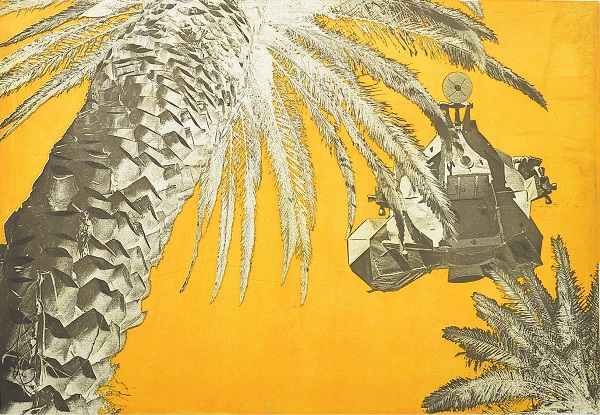 Palms and lunar module, 2017,, digital print on zinc plate, etching and, drypoint, paper, 50 x 70 cm
Palms and lunar module, 2017,, digital print on zinc plate, etching and, drypoint, paper, 50 x 70 cm
MODERN AND CONTEMPORARY ART: exhibition from the collection of the Museum of Modern Art Dubrovnik
Duration: 4.7. – 18.8.2019.
Curator: Rozana Vojvoda
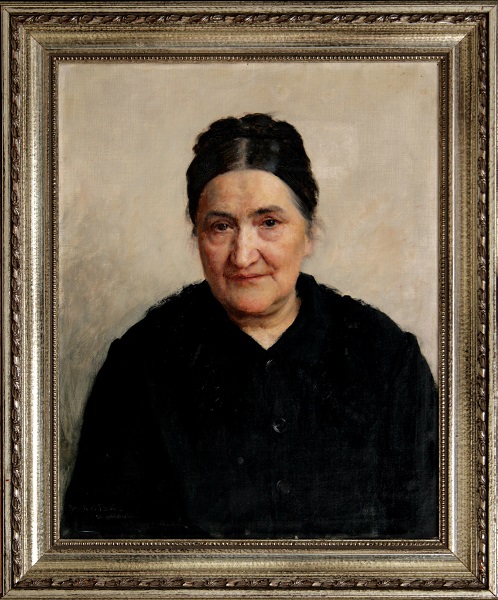
Vlaho Bukovac, Portret Katarine Bibica, 1891., ulje na platnu
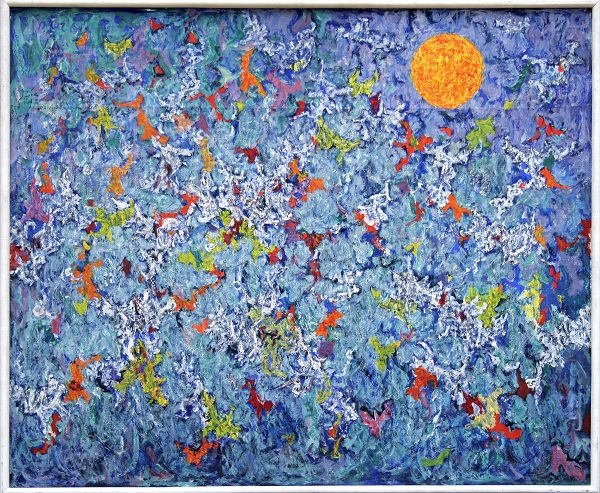
Ivo Dulčić, Dubrovačko ljeto, 1956., ulje na platnu
The exhibition MODERN AND CONTEMPORARY ART: exhibition from the collection of the Museum of Modern Art Dubrovnik presents a selection from the gallery’s collection that today counts over 2,700 works of art, covering the period from the late 19th century to the present. The three floors of the Villa Banac, one of the most beautiful buildings of Croatian modern architecture, are packed with works of art that include reflections of Impressionism, Expressionistic and Coloristic tendencies, abstract expression of the organic and geometric type of the fifties and sixties, postmodern painting tendencies of the eighties and art of expanded media that includes photography, video, and performing arts.
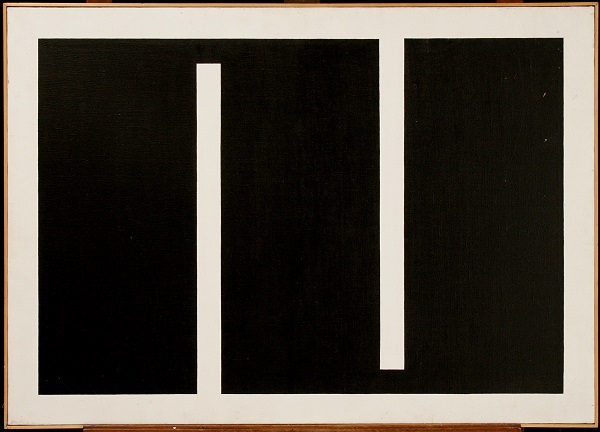
Julije Knifer, MX3, 1970., akrlik/platno
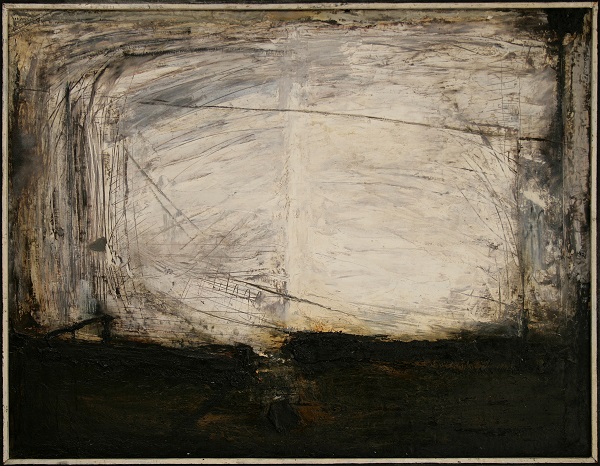
Ljubo Ivančić, Nebo i zemlja, 1959., ulje/lesonit
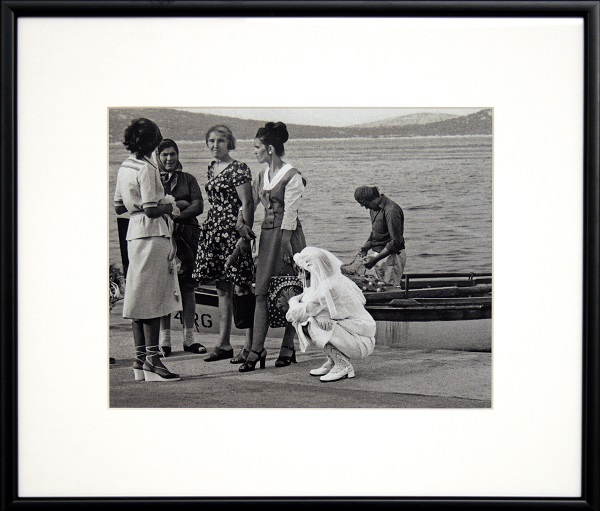
Mladen Tudor, Rogoznica, 1977., crno bijela fotografija
This exhibition is an opportunity for numerous domestic and foreign guests, who visit Dubrovnik in large numbers to visit and discover the quality and stylish pluralism of modern and contemporary art represented in the collection of the Dubrovnik Museum of Modern Art.
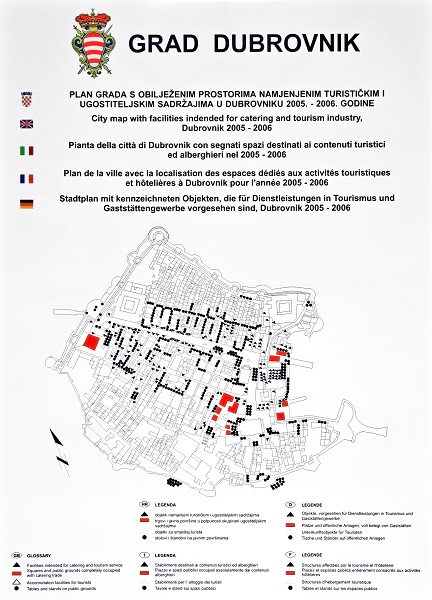
Slaven Tolj, Plan grada, 2006., print na prozirnoj foliji / metalna tabla

INTO THE LEAD SKY
Duration: 25.4. – 23.6.2019.
Curators: Branko Franceschi i Jelena Tamindžija
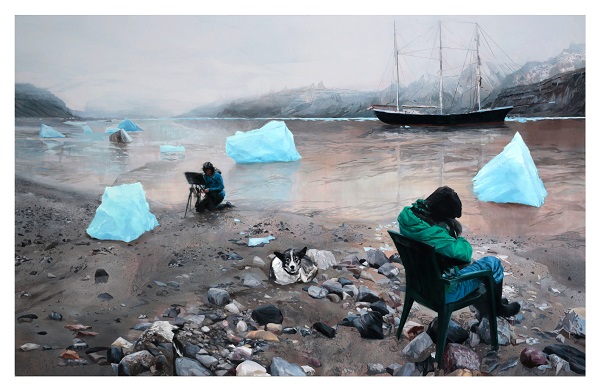
In October 2016 Zlatan Vehabović, one of the very best contemporary Croatian painters of the younger generation, took part in a yachting expedition the route of which extended into the last unfrozen region of the polar Arctic Sea off the coast of Svalbard Island.

The five weeks of intense activity during their stay included sailing, regular disembarkations on the uninhabited coastal area of the vast archipelago, active hiking and touring the inhabited and abandoned dwelling places and small towns of the region. The whole experience was documented photographically.
The role of the material recorded came to the fore on the artist’s return to the studio in Zagreb. With meticulous revision, the artist divided the recorded material into four groups of subjects, imposed partially by the very nature of the clime and partially by specific personal interests: the expedition, the landscape, the history and politics of the region and the ecological dimension of the artist’s experience of this extreme region.
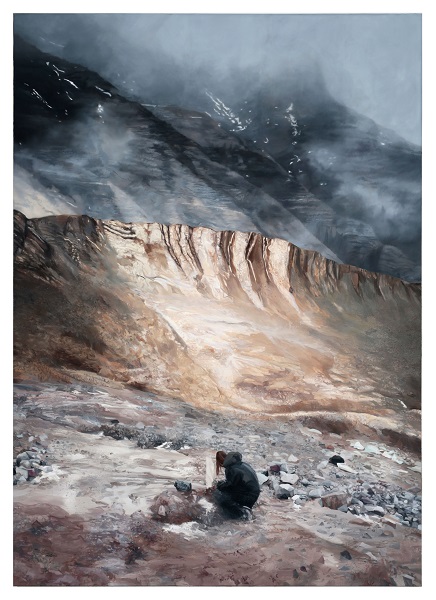
Biography:
Zlatan Vehabović, b. 1982 Banja Luka, lives and works in Zagreb, Croatia. He received his M.A. and Ph.D. from the Academy of Fine Arts Zagreb, Croatia. Solo exhibitions include: Museum of Contemporary Art, Zagreb (2015), Kranjcar Gallery, Zagreb (2011). Lauba House, MMC Luca, Pula (2010). HDLU, Zagreb (2009). Gallery Galzenica, Zagreb (2007). Gallery SC, Zagreb (2006). Selected group exhibitions include: Museum of Contemporary Art, Zagreb (2011). The Knoxville Museum of Art (2011). Hudson Valley Center for Contemporary Art, Peekskill, NY (2010). Essl Museum (2009). Paolo Maria Deanesi Gallery, Rovereto Italy (2010). Museum of Contemporary Art, Pula (2009). Werket Museum, Avesta Sweden (2008). S&G Galleries, Berlin (2008).

IVAN PERAK
SHIPS
Location: Gallery Dulcic Masle Pulitika
Duration: 21.3. - 12.5.2019.
Curator: Marin Ivanović
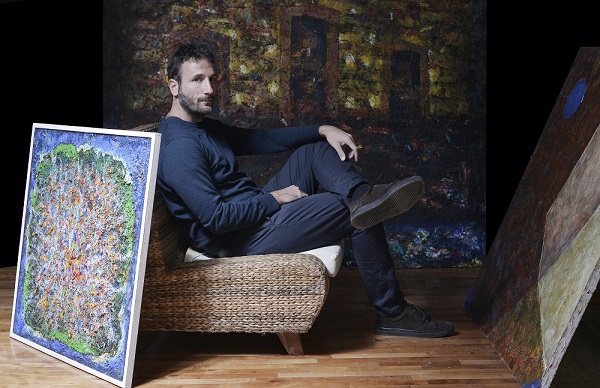
Famous for his expressive métiers d'art which is characterised by spot-colouring, Ivan Perak is an artist who breaks down visual form and creates abstract optical sensations, with the use of layered application of high-intensity colour. As such, his paintings are predominantly authentic colour experiments with a little connection to the famed Dubrovnik colourist tradition. This exhibition from the ‘Boats’ cycle will present the Dubrovnik artist’s talent in all its glory.
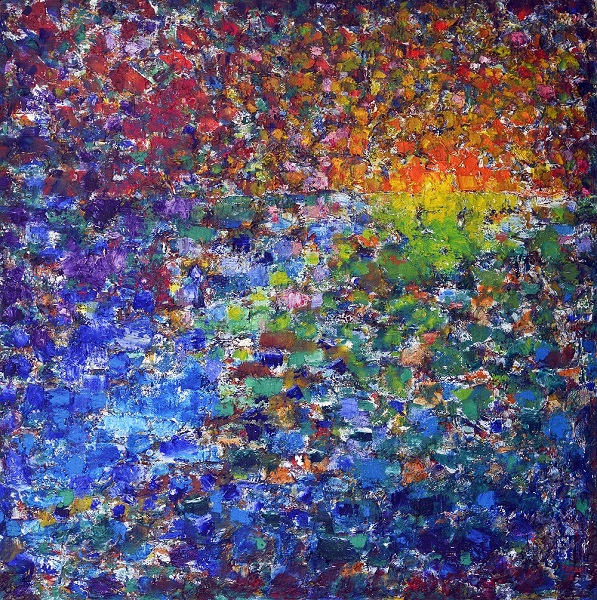
Twilight, 2016, mixed media on canvas, 170 x 170 cm, owned by Luka Šaldo
BIOGRAPHY:
Ivan Perak was born in 1983 in Dubrovnik. He took a degree in painting in 2007 in the class of Antun Boris Švaljek at the Široku Brijeg Academy of Fine Arts of Mostar University. He then attended and completed the postgraduate Ars Sacra course at široki Brijeg Academy of Fine Arts in 2009, supervised by Anto Kajinić. He has been the author of few artworks in public space: altar painting at the Holy Name of Jesus Catholic church in Dobri Do and mural paintings at the Ivan Gundulić Elementary School. He has taken part in many art colonies and a lot of charity work and is a member of the Croatian Association of Artists Dubrovnik. Besides working as a teacher, he is also a lecturer at the Department of Restoration and Conservation of the University of Dubrovnik. He lives and works in Dubrovnik and has shown his work at many individual and collective exhibitions at home and abroad.
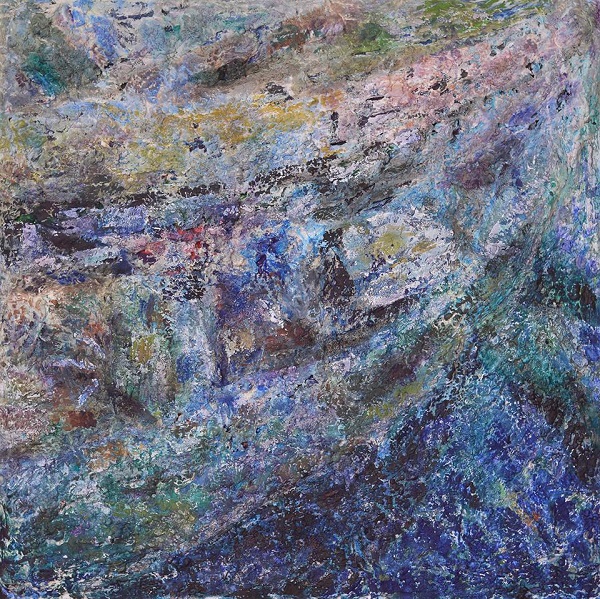
Ship 15, 2019, mixed media on canvas, 120 x 120 cm
TOMISLAV IVANIŠIN
WILD FLOWERS
Duration: March 16 – April 21 2019
Curator: Petra Golušić
Authors of texts in the catalogue: Petra Golušić and dr. sc. Antun Karaman
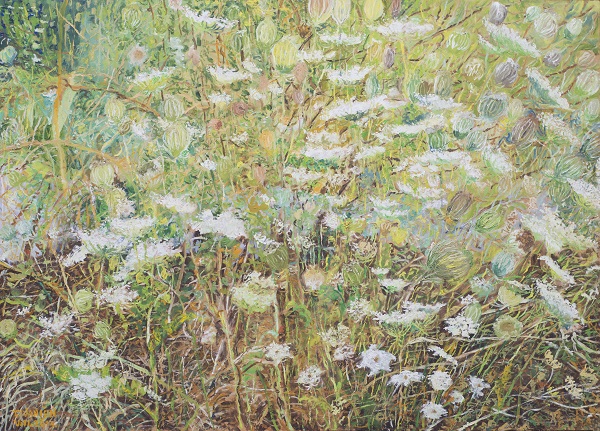
Arabeska II, 2013., ulje na lesonitu
Inherent in the painting of Tomislav Ivanišin is a strong thread that is kept up with and which is not relinquished. Line, colour, shape, blotch and form are combined into several diverse kinds of script, one of which is represented at the exhibition. Although it is a modernist convention of creation that is at issue here, the work is founded on the system of ideas, convicts and values. Vital essence is described subtly with the power of symbols that exist in nature, in confirmation of the never ultimately explored classical motifs; close in its expression to many of the histories and presents of art.
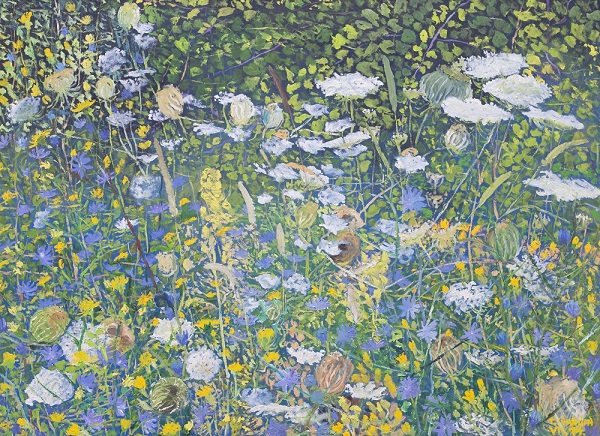
Wild Flowers, ulje na lesonitu, 2017.
The exhibition comprises the Wild Flowers series – a cartography made up of compositions of reality made precise. The landscape is the initial motif for a metaphysics of the territory in and about which expression. The process of observing objective reality of biodiversity is explored, and its spatial determination is cancelled out. The space of the image is built utopianly and labelled as a structured universal whole. The image of the world done in detail is thought through, felt and seen for it to be developed in its complexity, purposefulness and strength. Motif is broken down to its details, producing a vocabulary with which to register a microcosm whose ontology is examined. A world of plants like illustrations of some factual old fashioned botany book is revealed in the series.
Petra Golušić
All “the real” in Ivanišin’s paintings – the suggestiveness of the painted forms, the coherent use of colour, the surety of the brush stroke, the manner of painting wholes and details, the being-carried-away by the emotion and the density of poetic frisson and in particular the way in which the composition is framed – revealing “the truth of being”, explains what Heidegger calls “the general being of things”, in Ivanišin’s case a message of the exaltation of life and the unforced joy of revelling in closeness with all living beings, and the passion of a synergetic coexistence with nature. And if art is, mentioning Heidegger again, “the putting of the truth of Being into a work”, then Ivanišin has achieved his artistic vision of the world, which draws his attention and spurs his fancy, in the most noble manner of all.
Antun Karaman

BIOGRAPHY
Tomislav Ivanišin was born in Dubrovnik in 1942. In 1967 he qualified as an architect at the Architecture and Planning Faculty in Sarajevo, while learning painting from prof. Mladen Vukić. In 1971 took a Master’s at Rome’s La Sapienza University, having presented a dissertation on the theme of the renovation and revitalization of the Franciscan Monastery on Lopud. From 1967 he was engaged as architect on the international project Urban Plan of the Southern Adriatic, and was subsequently on the staff of the planning divisions in Dubrovnik. He is actively engaged in painting and is a member of the Dubrovnik Croatian Association of Visual Artists. He has exhibited at numerous exhibitions, solo and collective, in Croatia. He lives and works in Dubrovnik and at Drače, Pelješac Peninsula.
SOLO EXHIBITIONS (a selection)
1996. Bez naziva, crkva svetog Andrije i svetog Petra Starog _ Galerija, Zadar
2000. Dubrovački sutoni, slike nastale 1997. – 2000., Franjevački samostan _ Pinakoteka Gospe od Zdravlja, Split
2002. Moje bijele obale, Galerija Ronald Brown, Dubrovnik
2009. Slike, Hrvatsko društvo likovnih umjetnika Dubrovnik _ Galerija Flora, Dubrovnik
2013. Infleksije i refleksije mediteranskih boja od Sv. Jakova prema Dupcu, slike nastale 2006. – 2013., Palača Sponza, Dubrovnik
2017. Slika poništenog krajolika, 17. Festival Vizura Aperta, Dr
ASIM HEBIB
A RETROSPECTIVE
Location: Gallery Dulcic Masle Pulitika
Duration: 26.1.2019.-17.3.2019.
Curators: Milan Bešlić & Anita Ruso
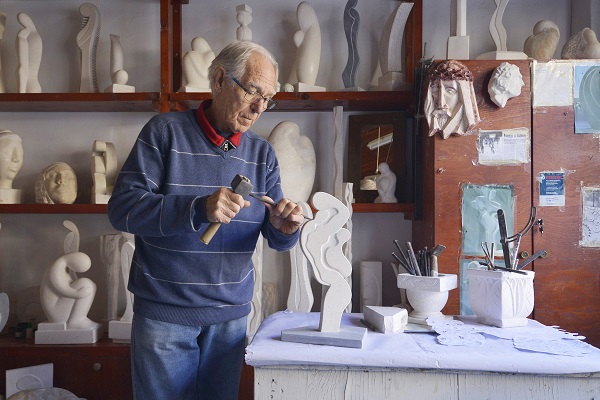
We have followed the long line that Asim Hebib’s sculpture has taken over the period of half a century, from the mid-1960s to works dated 2018. It is worth drawing attention to the time component in a survey of the path taken previously by this sculptor mostly so that we can refer to the author’s creative vitality and accordingly once again underline this fact as a vital feature. In this characteristic of the sculptor we see bit only the impressive temporal span within which he has formed his works but also the actual creative process in its changes, primarily sculptural changes, in the cognitive perception of the medium, the strengthening of stone carving skills and the perfection of the sculptural procedure, as well as in the diversity of motifs and materials. In this retrospective summation of the sculptural oeuvre, from works dated in this year, when we are already marking the end of the second decade of the 21st century, to those with which we start the reading of Hebib’s sculpture dated in the seventh decade of the 20th century, we have endeavoured to depict his sculptural creatures in something of the diversity of their motifs and materials. With a recent selection of works, by the method of synthesis, we have aimed at making clear precisely those sculptural features in which we can discern the traditional premises of rendering shape as those principles on which Hebib conceives his sculptural forms.
Milan Bešlić
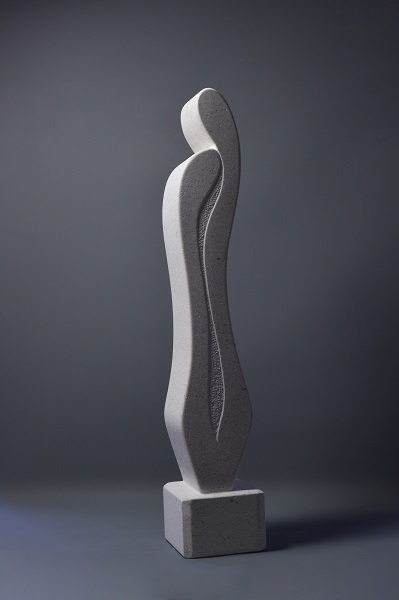
Twain / Elongated Forms, the series “Rhythms of Life”, 2007, Brač stone, 65.5 cm x 13 cm x 12 cm
Asim Hebib (Cernica, 1940), is, now in his seventy-eighth, year exhibiting in the Dulčić Masle Pulitika Gallery in Dubrovnik works from numerous series of pieces created over a broad span that stretches from his very beginnings in sculpture in the 1960s to the present day. Of the all-told thirty-six works on show, fully a half of them have never been exhibited. From his ample production, sculptures have been selected from eleven different cycles, created tirelessly during his lifetime in Dubrovnik. Writing of the Mediterranean and the artistic production of our regions, Academician Tonko Maroević once wrote: “What must be the greatest ever concentration of cultural monuments has been produced on the Mediterranean, an unequalled number of places that urge to and provoke creative pilgrimages have been brought together”. Hebib has authentically absorbed the light of the Mediterranean, of Dubrovnik, for it has clearly had an influence on the whole of his oeuvre.
Anita Ruso
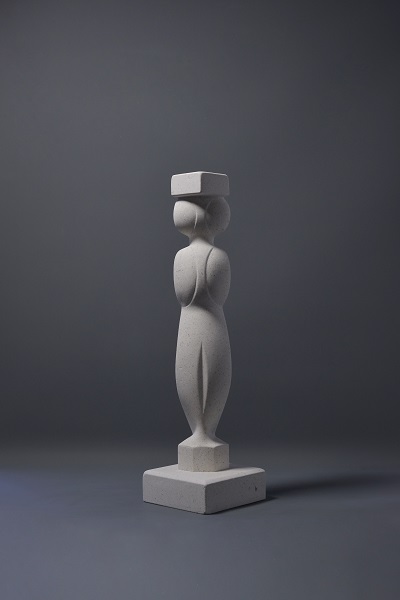
Konavle Girl, the series “My City”, 1977, Brač stone, 45 cm x 12 cm x 12 cm
BIOGRAPHY:
Asim Hebib was born in 1940 in Cernica. His first instruction in sculpture came from his art teacher in primary school, Ivan “Pajo” Mitrović. From 1957 to 1960 he trained with the Italian sculptor Giovanni Colonna in Dubrovnik, where he gained his sculpting and carving education. After this period of learning, Asim Hebib at the beginning of the 1960s started creating his first independent sculptural works, while also working for many years with Giovanni Colonna on various projects. He also took part in the Memorial Cemetery Mostar project of the architect Bogdan Bogdanović, on which for three years he was charged with the making of one part of the monumental symbolic reliefs. The Hebib Studio was founded in 1963 in Dubrovnik, and the sculptor still works in it today. He has created an important and distinctive sculptural oeuvre in its many thematic series. His works are placed in public places and are to be found in numerous private and public art collections. As well as with sculpture, Asim Hebib also occupies himself with decorative stone carving and drawing, and writes poetry as well. He is an active participant of numerous art colonies in Croatia. He has exhibited at numbers of solo and collective shows in Croatia.
JASENKO RASOL
POLITICAL SCHOOL / DYSTOPIA / PALE IMAGE
Duration: 22.11.2018.-20.1.2019.
Curator: Petra Golušić
Concept: Jasenko Rasol
 Political School Series, 2017, digital colour photography - inkjet printout, 100 x 150 cm
Political School Series, 2017, digital colour photography - inkjet printout, 100 x 150 cm
The human being. Pain. Death. Life. nothing - code of the absolute spirit. This, and other things, the exhibition states with its universal vocabulary. Rasol's work is part of the world process of peace, freedom, justice and so on. Three series of digital colour photographs are on show: Political School (2017), Dystopia (2016) and Pale Image (2018), with twenty-one frames that are part of wholes and a separate erotics of a cold, sensitive, powerful and wise aesthetic. There is nothing wanting, nothing superfluous; in them, the wasteland is written with the system of shots of pared-down scenes of the abandoned and the rejected. Territory and theory and personal style and so on of the contemporary Croatian artist are close as in many authors of the history and present of photography and so on.
Petra Golušić
 Political School Series, 2017, digital colour photography - inkjet printout, 100 x 150 cm
Political School Series, 2017, digital colour photography - inkjet printout, 100 x 150 cm
BIOGRAPHY:
Jasenko Rasol was born in Zagreb in 1969. Since beginning his career in photography, he has been working as an independent cameraman and photographer. Many photography monographs have been published about Rasol’s works: Silba, August 1994 (Jasenko Rasol, Zagreb, 1995), Irma (Meandar, Zagreb, 2003), Covered (Meandar / Scaner Studio, Zagreb, 2004), Photo souvenirs (Meandar, Zagreb, 2009.) and Winter Gardens (Meandar Media, Zagreb, 2011.). Rasol started exhibiting his works at the beginning of the 1990’s and has since been featured in many solo and group shows in Croatia and abroad. He currently works and lives in Zagreb.
Tomo Gusić
LOOKING BACK, TWO-FOLD / a retrospective exhibition
Museum of Modern Art Dubrovnik
18 December 2018 – 10 March 2019
exhibition curators and text authors: Prof. Antun Karaman, PhD, Assist. Prof. Marija Tonković, PhD

Stradun, 2000, oil on canvas
The paintings of Tomo Gusić – Within the Silences of Selfhood
Antun Karaman
STILL LIFE In the prolific production of paintings dealing with the subject of still life, a complex with characteristic content stands out – the portrayals of various types of shellfish and seafood (garfish, oysters, mussels, sea urchins), which do not merely represent the symbols of life in the sea and by the sea, and/or the synonyms for good food, but have already imposed, i.e. affirmed themselves as an ever-interesting motif that is in fact timeless and universal, as a motif that, regardless of the time and place of its creation, can serve as an excellent template to the artist who painted it, enabling him to enter into a dialogue with the period in which he lives and works.
THE CITY In the overall consciousness of the world, in the minds of the passers-by or chance visitors, as well as in the dreams and imagination of the admirers of all its faces and all of its mysteries, Dubrovnik always gleams and shines as the City, as a phenomenon and as a concept, and to the people of Dubrovnik (and Gusić is one of them), their Dubrovnik is often and much more than all of that.
To the artists, the City represents both a splendid motif and an enchanted mirror (with the inevitable traps of mimesis) in which it is not always easy to find one’s way. At the same time, it serves as an inexhaustible source of inspiration to them, a mirror image of real values and a magical gateway to the worlds behind the apparent state of things, a doorway to imagination and dreams, which, in many ways, encourages the artists (as well as all of us – the other, ordinary people) and directs them positively, but also sometimes limits them in an unwelcome manner.
Gusić knows this all too well. He definitely feels all of the virtues, flaws and seductive qualities of the City's appeal, but is sufficiently strong and capable, both mentally and creatively, of resisting its opulent challenges and facing the City in its enchanted mirror without any fear. Gusić evaluates the City in the right way – he worships it, but also looks at it in his own way. After all, the City has not been far away from him, both during his childhood and presently, neither spiritually nor physically; it is constantly on his mind and in his sight, he can almost touch it with his hand. In the morning, when he opens his bedroom window or goes out into the small garden in front of the house, the northern town walls, the beautiful Minčeta Tower, the solidly built forts of St Barbara, St Catherine, Drezvenik and St Jacob, regardless of whether they are lit by the already-risen sun or caught in the rain, cheerfully wish him a good morning, every single time.
The direct contact with the vistas of the walls and the dreams of the City immerses Gusić in his own dreams and stories: from his elevated perspective he curiously observes the walls and peeks behind them; sometimes rising to the heights, flying with the birds and looking down on the City from above, from the zenith, experiencing it in its idealized, emblematic layout, and then landing into the complex simplicity of the narrow city streets and into the harmony of uniform blocks of townhouses; and in this restless kaleidoscope of street stairways, house façades, rooftops, and proud-standing belfries, he awakens and nurtures his soul.
STRADUN, THE MAIN STREET OF DUBROVNIK By repeatedly painting Stradun and its numerous faces, Gusić presents not only his artistic credo, his spiritual preoccupation and painting process, but also his reflections on the dynamics of life and the world, and all of his psychological, emotional, philosophical and poetical and artistic opinions and attitudes. In every “portrait” of Stradun he actually “portrays” himself and his own artistic universe, pointing out his inventio in which the topos of Stradun becomes much more than a theme of the painter’s life and his paintings that he holds dear, and much more than the main street, the beating heart of Dubrovnik. Here, in Gusić's interpretation, Stradun, or rather the various paintings of Stradun, become a gold mine of information, a repository of arguments, and a means of identifying the repeatedly affirmed creative upswings and the true nobility of the human spirit and actions, as well as interpersonal relationships and relationships in general.
THE PROCESSION In painting the paintings containing the motif of a procession, of which there are quite a few, Gusić is presented with the opportunity to bring himself even closer to (his known) self. Likewise, he reveals an artist who successfully equilibrates between two disparate phenomena: at times he is a very accurate observer, inclined to giving realistic accounts and producing in-depth analyses of either the details or the entire complex, whereas at other times he gives himself freely to the enjoyable freedom of playing and the accelerated rhythms of action and colors, thereby coming close to syntheses, stylization and, almost, abstraction.
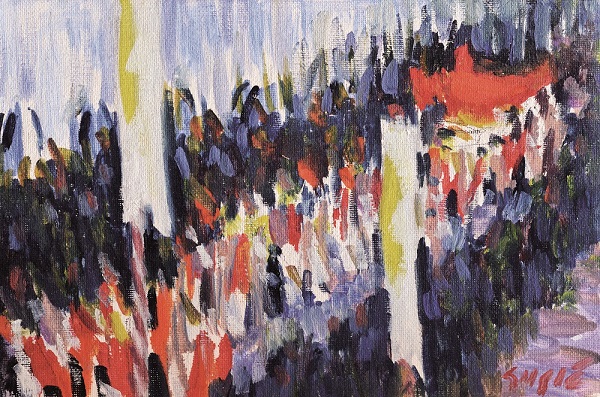
Procession, 2002, oil on canvas
THE GARDEN In view of the content and the descriptiveness of details in the paintings containing the motif of a garden, Gusić is somewhat more inclined to mimesis and more solid forms than when he is painting still life or Stradun. But in terms of the psychological-experiential aspect and the painting process, his intent is always the same or similar. The nostalgic edge, the sadness due to transience, the persuasiveness of the atmosphere and the ambience, the noble consonance of colouring, the smooth permeation of tones, the steady ductus and the ease of painting all give these paintings an aura composed of almost contradictory emotions – the merriment and joy of living and the existential anxiety permeated by melancholy and Watteau-like restrained poetics.

Terrace, 2005, oil on canvas
THE PORTRAIT Each of the painted portraits contains a particularity and an original specificity, whether in the choice of coloring characteristics, the calmness/restlessness of the ductus or in the structural formation of the composition.
THE NUDE FIGURE The body is also an expression and a mirror image of the human soul. Gusić's nude figures primarily emit a noticeable anxiety, uncontrollable melancholy, despondency, self-abnegation and the insecurity of youth, and thus the suppression, and closing-off to the challenges of the outside world, as well as true worry over the uncertainties and entrapments of life; subsequently followed by the awareness of one’s newly discovered, newly burgeoned and/or already thriving maturity or sexuality and of the (suppressed, latent) sensuality that are, whether they want to or not, laid before the altar of men's (sometimes unattainable) desires.
Applied art in the illustrations and graphic design by Tomo Gusić
Marija Tonković
Making a living solely from the painting was never an easy or simple task, in any given time period. In connection with his opus as a painter, all of the biographies of Tomislav (Tomo) Gusić mention only his diploma and specialization year at the Academy of Fine Arts, in the class of Oton Postružnik. Fortunately, at the time of his studies, great attention was paid to the mastering of graphic skills and techniques as well. The founder of Croatian design, posters and book design, Tomislav Krizman, taught him during the first two years. After his retirement, Frano Baće took over these subjects, and, continuing in Krizman's tradition, insisted on lettering style and typography, nurturing and maintaining the high quality of the art of “sign painting”.
During the sixties and seventies of the last century, the demands of rare clients, namely the official organizations of the political system, had to be met, so his works reflect the social, cultural and political circumstances. Printing capabilities were much less developed than nowadays. Publishers often decided upon the technique that the illustrators could use, so the books of that period were often illustrated only by line drawings. In the editions of individual works, the limits of visual originality were strictly set, to the benefit of the common, pre-determined and recognizable identity of the edition.
In this environment, like many notable Croatian painters, Tomo Gusić also started working in different fields of applied graphic arts. He designed newspaper editions (Telegram, Smib), made posters, designed and illustrated books, and also designed the overall visual identity for individual clients. He intensively worked on illustrations for children's literature, ranging from simple flat monochrome drawings in India ink to the complex painting compositions. The relationship with the text is complementary: the text and the picture complement each other.
In his first book, Alica u zemlji čudesa (Alice in Wonderland) (1964), which saw twelve editions, he attempted to conform to the visual perception of little readers. His feather drawings are made up of lines with differing intensity – from the completely thin to the striking ones, from short strokes to the ones transforming into blots, imitating children's drawings. Gusić's engagement soon expanded to the design of the entire book, including the cover page, endpapers, and illustrations. The visual representation became dominant and was realized by utilizing a combination of different techniques: decalcomania, collage, ranging from airy watercolor paintings to the saturated and completely paint-covered surfaces (Društvo nečistih (The Society of the Unclean), 1969). The picture occupies the largest part of the sheet surface, intertwining itself with the text both visually and semantically, in various styles and genres of children's illustration (Zebre lete na jug (Zebras Fly South), 1981). On the covers, he subtly organized the semantic data, as well as the typographic and visual elements (Uvijek netko nekog voli (There Is Always Someone Loving Someone), 1986). The illustrations in which he completely dissolved the painting palette are wrapped around the songs, encapsulating them in multiple dialogues and in perfect synergy with their textuality (Ledomat tata (The Ice Maker Dad), 1985).
In the design of posters, logos, and catalogue design, Gusić’s work reflects the tradition of the international graphic style. He portrays the synthesis of the vital forces in relation to the art of geometric aesthetics which, in the 1970s, became the general lexis of the spirit of that age. Gusić's posters and logos for the Dubrovnik Summer Festival, Sebastian Gallery, Vatroslav Lisinski Concert Hall and Atlas Travel Agency further and develop the design-related orthogonal tendency of Croatian graphic design. It could also be stated that it serves to conclude, in the outlines, the general line of Exit morphology.

Poster for the Carneval fest in Cavtat, 1977
Gusić identifies characteristic features that he transposes into effective symbols, combining them with modern typography. As for the individual occasions, his work is less constrained, with emphasis on the pictorial, while maintaining the efficiency and purity of textual information. This selection of Gusić's works in the area of applied graphic arts serves to incorporate his highly valued opus into the history of Croatian design.
BIOGRAPHY:
Tomo Gusić /born 1931/, after his elementary and secondary education in Dubrovnik, enrolled in the architectural course at the Engineering Faculty in Zagreb. In 1953 he passed the entrance exam to the Academy of Fine Arts in Zagreb, also signing up for the painting course of Oton Postružnik. He took his BFA in 1957, and completed post-graduate work in 1959. In 1960 he returned to Dubrovnik, going back again to Zagreb in 1963, where he took part from time to time in the collective exhibitions of the Fine Artists’ Association, also practicing the business of graphic design; in addition, he worked as art director for the publisher Školska knjiga. In 1981 he left Zagreb, and has ever since lived in Dubrovnik.









